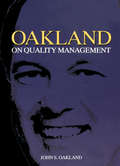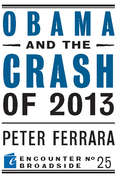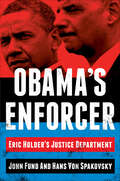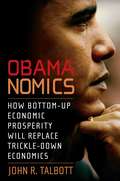- Table View
- List View
OXXO's Turf War Against Extra (A)
by Annelena Lobb Tatiana Sandino Gerardo Perez CavazosIn 2006, Mexican convenience store chain OXXO faced a threat from a formidable competitor, the rival convenience chain Extra. OXXO had embarked on an initiative to fortify its corporate culture and operating system, but the threat of Extra raised the question of whether they should focus on opening as many stores as possible and as quickly as possible, in order to maintain market leadership. CEO Eduardo Padilla had to define his strategy and decide whether to focus on improving culture and operations or on relentlessly beating its rival.
OXXO's Turf War Against Extra (A)
by Annelena Lobb Tatiana Sandino Gerardo Perez CavazosIn 2006, Mexican convenience store chain OXXO faced a threat from a formidable competitor, the rival convenience chain Extra. OXXO had embarked on an initiative to fortify its corporate culture and operating system, but the threat of Extra raised the question of whether they should focus on opening as many stores as possible and as quickly as possible, in order to maintain market leadership. CEO Eduardo Padilla had to define his strategy and decide whether to focus on improving culture and operations or on relentlessly beating its rival.
OXXO's Turf War Against Extra (B)
by Annelena Lobb Tatiana Sandino Gerardo Perez CavazosIn 2006, Mexican convenience store chain OXXO faced a threat from a formidable competitor, the rival convenience chain Extra. OXXO had embarked on an initiative to fortify its corporate culture and operating system, but the threat of Extra raised the question of whether they should focus on opening as many stores as possible and as quickly as possible, in order to maintain market leadership. CEO Eduardo Padilla had to define his strategy and decide whether to focus on improving culture and operations or on relentlessly beating its rival.
OXXO's Turf War Against Extra (B)
by Annelena Lobb Tatiana Sandino Gerardo Perez CavazosIn 2006, Mexican convenience store chain OXXO faced a threat from a formidable competitor, the rival convenience chain Extra. OXXO had embarked on an initiative to fortify its corporate culture and operating system, but the threat of Extra raised the question of whether they should focus on opening as many stores as possible and as quickly as possible, in order to maintain market leadership. CEO Eduardo Padilla had to define his strategy and decide whether to focus on improving culture and operations or on relentlessly beating its rival.
OYO: Creating Effective Spaces
by Sunil Gupta Das Narayandas Rachna Tahilyani Mahima Rao-Kachroo"In August 2017, Ritesh Agarwal, CEO and founder of Gurugram-baseda OYO, an online, curated, hotel room marketplace that provided reliable and quality budget rooms, announced the launch of OYO Asset Management (OAM). OAM was the brand for the services that OYO provided property owners looking to transform their under-utilized properties such as hotels, houses and corporate spaces, into modern, fully-furnished hotels.1"
OYO: Creating Effective Spaces (Abridged)
by Sunil Gupta Das Narayandas Rachna Tahilyani Mahima Rao-KachrooTwenty-four-year old Ritesh Agarwal, founder and CEO of India-based online, hotel branding network OYO Rooms, has tackled the issue of unreliability in India's highly-fragmented budget hotel industry. In 2018, OYO branded 8,500 properties across 200 cities and managed to capture almost 1.5% of India's budget hotel market. Ritesh believes that in the process, OYO has honed technological skills and infrastructural capabilities that can transform the company from being a technology player to a hotel developer. OYO now aspires to convert corporate spaces and homes into accommodation spaces, and to make its mark worldwide.
Oak Street Health: A New Model of Primary Care
by Michael E. Porter Thomas H. Lee Meredith A. AlgerCase
Oak Street Health: A New Model of Primary Care
by Michael E. Porter Thomas H. Lee Meredith A. AlgerCase
Oakdale Cotton Mills (Images of America)
by Mary A. Browning Patricia M. KoehlerOakdale Cotton Mills, in continuous operation in rural Jamestown since 1865, began as Logan Manufacturing Company immediately after the Civil War. Its primary backer, Cyrus P. Mendenhall, was a descendant of Jamestown's early Quaker settler James Mendenhall. In the late 1880s, the mill's ownership moved to the Ragsdale family, which still owns it five generations later. Oakdale's mill village dates from the same period. Some families have lived and worked at Oakdale for multiple generations, developing a culture based on mutual trust and respect. As the mill struggles to compete with overseas products and as the number of employees dwindles, it is clear that a way of life and an industrial era are ending.
Oakland A's: Baseball's Great Transformation
by Leonard A. Schlesinger Mark PelofskyThe Oakland A's baseball team underwent a major turnaround during the 1980s, both on the field and in the business office. One of the most significant improvements came in the area of customer service. The A's management believed that if they took care of their fans, they would remain loyal through winning and losing seasons.
Oakland on Quality Management
by John S Oakland'Oakland on the New Quality Management' shows managers how to implement a Total Quality Management strategy throughout all activities and thereby achieve top quality performance overall, not just focusing on product or service quality. The text addresses the issues of implementing TQM, teamwork, and changes in culture, and emphasizes the integration of TQM into the strategy of the organization with specific advice on how to implement TQM. Topics covered include quality function deployment (QFD), communications and quality strategy, measurement and benchmarking, and teamwork for culture change, including the 'Drive' model. Ten points are presented to aid senior management in their thinking on commitment, culture and communication issues.
Oaktree and the Restructuring of CIT Group (A)
by David S. Scharfstein Victoria IvashinaCIT's prepackaged bankruptcy marked the first time a major financial institution was able to successfully restructure and emerge from Chapter 11 bankruptcy, challenging conventional views that a financial firm could not survive bankruptcy proceedings as a going concern. A diverse group of private investors that had accumulated a large position in CIT in the period leading up to the restructuring played a central role in the success of this restructuring. The case protagonist is Rajath Shourie, Managing Director at Oaktree Capital Management. Shourie evaluates the opportunity to extend a $3 billion rescue credit facility to CIT, together with five other large creditors of the struggling bank. The decision takes place just one day after CIT was denied access to the Temporary Liquidity Guarantee Program (TLGP). This case provides a platform for discussing what constitutes a good attractive distressed target. (In parallel, students can gain in-depth insight into alternative financing models of corporate lenders, including banks and finance companies.) The second major component of the case concerns distressed debt investment strategies, and provides an illustration of turning an investment in public debt into a position of control over CIT's management and the restructuring process.
Oaktree and the Restructuring of CIT Group (B)
by David S. Scharfstein Victoria IvashinaThis supplement presents the actual terms of the rescue financing provided by a group of private investors to CIT. It is intended to be distributed at the end of the discussion of "Oaktree and the Restructuring of CIT Group (A)" (HBS No. 214-035) and can be used as background to reflect on the students' proposal of financing terms for the $3 billion rescue financing of CIT.
Oaktree: Pierre Foods Investment
by Victoria Ivashina Mike HarmonCase: HBS Professor Victoria Ivashina and Mike Harmon prepared this case. Mr. Harmon is the Managing Partner of Gaviota Advisors, LLC in Manhattan Beach, CA and is a former Managing Director with Oaktree. It was reviewed and approved before publication by a company designate. Funding for the development of this case was provided by Harvard Business School and not by the company. HBS cases are developed solely as the basis for class discussion. Cases are not intended to serve as endorsements, sources of primary data, or illustrations of effective or ineffective management.
Oaktree: Pierre Foods Investment
by Victoria Ivashina Mike HarmonThis case is a setting to discuss "loan to own" investment strategy that is often pursued by distressed investors. The aftermath of the 2007 financial crisis left many companies with poor liquidity and limited ability to obtain credit. One of these companies was Pierre Foods, a producer and distributor of processed and precooked protein products that had experienced several years of promising sales growth and held a leading market position. Despite this, 2007 saw Pierre foods adversely affected by a spike in production costs and unsustainably high leverage. This made Pierre Foods an attractive opportunity for Oaktree Capital Management, allowing them to employ its strategy of investing in distressed debt securities with the goal of leading a restructuring during which their debt investment would be converted into a controlling equity stake. The challenge of executing "loan to own" strategy is being able to identify ahead of the restructuring the debt layer that stands to becoming equity (the so called "fulcrum security"). Overall, this case can be used to understand unique elements of a representative distressed investment. It can also be used as a platform for discussing sources of value and risks associated with distressed investing.
Oaktree: Pierre Foods Investment
by Victoria Ivashina Mike HarmonThis case is a setting to discuss "loan to own" investment strategy that is often pursued by distressed investors. The aftermath of the 2007 financial crisis left many companies with poor liquidity and limited ability to obtain credit. One of these companies was Pierre Foods, a producer and distributor of processed and precooked protein products that had experienced several years of promising sales growth and held a leading market position. Despite this, 2007 saw Pierre foods adversely affected by a spike in production costs and unsustainably high leverage. This made Pierre Foods an attractive opportunity for Oaktree Capital Management, allowing them to employ its strategy of investing in distressed debt securities with the goal of leading a restructuring during which their debt investment would be converted into a controlling equity stake. The challenge of executing "loan to own" strategy is being able to identify ahead of the restructuring the debt layer that stands to becoming equity (the so called "fulcrum security"). Overall, this case can be used to understand unique elements of a representative distressed investment. It can also be used as a platform for discussing sources of value and risks associated with distressed investing.
Oasys Water: Balancing Strategic Partnerships & Financing Decisions
by William A. Sahlman Ramana Nanda Sid MisraCase
Obama and America's Public Sector Plague
by Edmund J. McmahonPublic-sector employees enjoy much more generous pay and benefit packages than private-sector workers, including guaranteed pensions and retiree health benefits whose long-term costs threaten to break the backs of state and local taxpayers. In this provocative Broadside, E.J. McMahon explains how the policies of the Obama administration have shielded most state and local government employees from the worst effects of the Great Recession. President Obama's stimulus bill helped most states and local governments continue raising average employee pay even at the depths of the downturn. In the name of promoting "economic recovery," the president wants to spend tens of billions more to prop up government payrolls and preserve cushy employee benefits. Meanwhile, public-sector labor unions are exploiting their influence in Washington in an bid to expand and strengthen their power throughout the country. The president's push for more federal spending to preserve the status quo in state and local government is a wasted opportunity to promote much-needed structural reform.
Obama and the Crash of 2013
by Peter FerraraMost people do not know that already enacted in current law for 2013 are increases in the top tax rates of virtually every major federal tax. That is because the tax increases of Obamacare become effective that year, and the Bush tax cuts expire, which Obama has refused to renew for the nation's small businesses, job creators and investors.Also by 2013 Obama's regulatory tsunami will be building to a crescendo of increased costs on the economy. And the Fed, now committed to maintaining loose monetary policy through the election, will be reversing course right after to head off inflation, which will add to the contractionary effects on the economy.The result will be one whopping, horrendous, record shattering recession, unless America changes course. In this explosive Broadside, former Reagan White House policy advisor Peter Ferrara exposes the final calamitous consequences of Obama's assault on prosperity
Obama versus Clinton: The YouTube Primary
by John Deighton Leora KornfeldWhat was the role of the Internet in the contest for the Democratic presidential nomination between Senators Obama and Clinton? How does the role change in the shift from the Primary to the National election? The case examines media and content choices by each candidate, and allows students to explore the role of new media in political campaigns. The focus is on fundraising in 2007 and campaigning for Primary delegate votes in 2008.
Obama's Enforcer: Eric Holder's Justice Department
by John Fund Hans Von Spakovsky“A book that should be required reading for any citizen concerned with the unprecedented erosion of the rule of law under the Obama administration.” —Luther Strange, former U.S. SenatorIn Obama’s Enforcer, authors John Fund and Hans von Spakovsky provide the first explosive look inside the feared and powerful Department of Justice. They describe the transformation of the DOJ into a stronghold of progressive legal activism and provide in-depth portraits of the radical lawyers in Eric Holder’s inner circle.Holder survives because his agency acts as a heat shield for the Obama administration, protecting the president’s flank on numerous fronts. He also survives because his department is actively advancing Obama’s hidden political agenda, from the administration’s war on Fox News to its harassment of Tea Party activists. He has injected a new politically correct laxity into domestic security issues, eliminating the use of the words “radical Islam” and pushing for civilian trials for terrorists. He has also presided over an unprecedented expansion of politically correct actions at the DOJ’s Civil Rights Division and launched a widespread attack on election integrity efforts.In addition to monitoring reporters’ phone records, DOJ lawyers were involved in instigating Operation Fast and Furious, ignoring the deliberate leaking of classified documents by the White House to favored reporters, the funneling of taxpayer funds to political allies through collusive settlements, and much more. Obama’s Enforcer provides the first investigative look inside the country’s largest law enforcement agency and reveals its true and dangerous role in advancing Obama's agenda.“Obama’s Enforcer catalogues the abuses of power at the Department of Justice under Attorney General Holder.” —Senator Ted Cruz
Obamacare
by Matthew C. Weinzierl Katrina FlanaganOne vote in June, 2012, decided the fate of President Barack Obama's crowning first-term achievement: universal health insurance. Chief Justice John Roberts of the U.S. Supreme Court cast the deciding vote to uphold the keystone of the reform: the mandate to purchase insurance. That mandate had a convoluted history. Though born in a conservative think-tank and originally adopted by Republican leaders as a necessary component of reform, it was rejected by Republicans when taken on board by the President and Democrats. Roberts' decision rested on an interpretation of the mandate as a tax. Instructors may also obtain a Teaching Note, written by this case's author, that provides suggestions for using this case effectively in the classroom.
Obamanomics: How Bottom-Up Economic Prosperity Will Replace Trickle-Down Economics
by John R. TalbottBestselling author John R. Talbott, who predicted the housing and mortgage crisis, pictures in Obamanomics--written well in advance of the historic 2008 elections--a Barack Obama presidency based on justice and cooperation--principles that have not held sway in Washington, DC, for quite some time. Talbott's powerful grasp of finance allows him to connect the issue of financial inequality in America with our need as a people to embrace change.Obama has shown he knows that divisions among races, religions, and political views have prevented Americans from coming together to solve the most important problems of our age. Obamanomics, infused with Obama's speeches, campaign policy statements, and other writings, describes a government acting according to democratic principles to enact lobbying reform, get our economy moving again, fix our healthcare system, slow global warming, prevent unnecessary wars, improve education, address the aging of our population, find alternative energy sources, and bring about housing, mortgage, and banking reform.
Oberoi Hotels: Train Whistle in the Tiger Reserve
by Ananth Raman Vidhya Muthuram Ryan W. BuellCelebrated as one of the world's premiere luxury hotel brands, Oberoi Hotels attracts and serves some of the most quality sensitive guests in the world. The case considers the challenge of how an organization, with a standardized service model, can repeatedly delight customers whose expectations grow with every interaction. To explore this question, the case details the design elements of Oberoi's complex service operation, including its approaches to employee management and continuous improvement, as well as the dynamics of service competition in a rapidly growing market.
Obesity Management at Kaiser Permanente: A New Mindset for Healthcare Delivery?
by Kevin Schulman Christiana Beveridge Gregory LeyaKaiser Permanente (KP) is the largest managed care organization in the US with over 10 million members. KP evolved from a pre-payment or capitation model that focuses the organization around the efficiency of care and the health of the population it serves. This financial model is in stark contrast to the fee-for-service payment model for other health care organizations. Given the epidemic of obesity in the US, KP is facing an enormous potential liability from future costs of obesity and diabetes. Given low turnover in health plan membership, how should they respond to this crisis? How should they invest in the health of their covered population, their employees, and the communities they serve? The case details the origins and development of KP.






